The last six weeks have brought a partial market recovery. Most of the media and financial reporters have been telling us how much better everything now seems.
The job market remains robust, with unemployment hitting new historical lows. Additionally, new unemployment claims are trending low without any real hiccup.
Inflation is trending down. Gas prices have been falling for 6-8 weeks. (At this rate, maybe we will get to $1 a gallon soon).
Tech stocks have come roaring back and are in a new bull market (defined by some as up 20% from the lowest point in June). Most folks are feeling relieved and are in better shape on their overall portfolio now.
These are just a few of the things the media has been writing and broadcasting over the past couple of weeks. It is also what friends and clients are sharing with us as well.
We always try to get you a fair and balanced outlook. Speaking of The Outlook, see the definition below (from Merriam-Webster)
Definition of outlook
1a: a place offering a view
b: a view from a particular place
2: POINT OF VIEW (positive outlook on life)
3: the act of looking out
4: the prospect for the future
While we like to paint a favorable outlook, we feel it is our responsibility and duty to help point out where the landmines reside.
MarketGauge investment strategies put risk management first.
It doesn't matter whether the strategy is…
…Our guru, Mish, with her discretionary portfolio,
…A quantitative algo strategy that trades stocks, ETFs, or cryptocurrency,
…An optimized blend of our strategies, or
…Our proprietary indicators, screens, and innovative ways to look at the market (i.e. Big View) that give you insight into the market's next move that you can't find elsewhere.
Reduced risk, lower volatility of returns, and minimizing drawdowns are just as important to deliver as percentage gains.
Therefore, to help you risk manage your portfolio (unless you want us to do it for you, and we would be glad to help), we need to constantly remind you where the current narrative may be getting it wrong.
Here are some of this week's current observations:
- August has been a good month so far. The S&P 500 and Nasdaq 100 are both up approximately 2.4%. Small cap stocks (IWM) are up 4.0%. Risk on assets have benefited from this rally. However, August trading, as usual, has seen light volume, so moves are accentuated and often trend.
- Friday saw the first significant down day in a while. This may have been tainted by the emphasis of expiring options or on technical resistance as we cover below.
- Inflation remains elevated, and there are still Fed Governors that believe the next hike in September should be 75 basis points. This would be consistent with the last two historical hikes.
- Interest rates have been trending up this week. With falling commodity prices, bonds rallied the past month to 2.6% on the 10-year. This week bonds sold off, and rates closed on Friday right under 3.0%. The 10-year interest rate is now hitting resistance at the 50-day moving average. See the chart below.
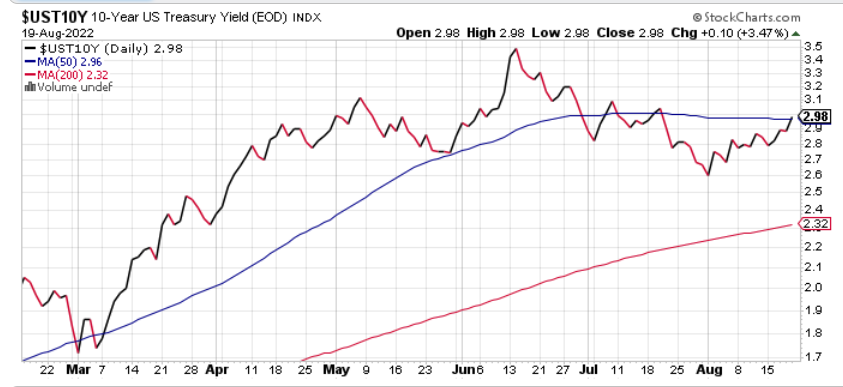
- Commodities have been rebounding from their mid-summer sell-
- Energy started rising again this past week.
- After an early summer (seasonal) sell-off, Natural Gas has come roaring back and hit fresh new highs this past week. (this is one of MarketGauge's current holdings in one of our Algo strategies). As a direct result of the Russia-Ukraine incursion, Europe is already anticipating shortages in some countries. This has exacerbated an already costly energy market, especially in Europe. See below.
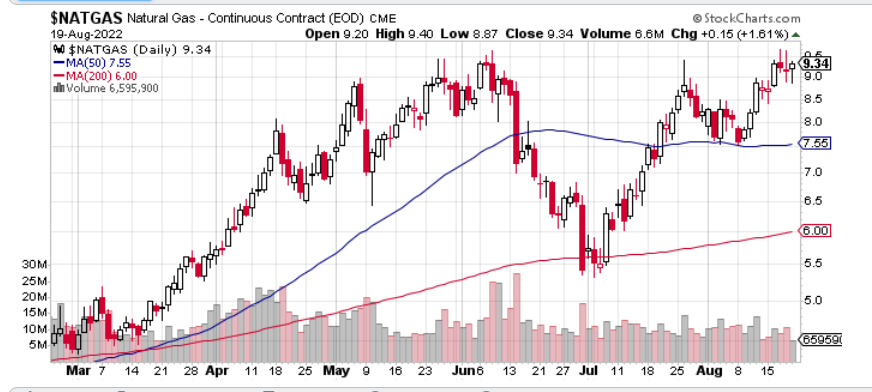
Watch Out. More signs that could derail the economy and the markets:
There are plenty of "landmines" that exist out there. Let us briefly cover each that are most relevant at this time:
1. Inflation
With food, rent, and energy prices remaining high, it is unlikely that inflation will come down soon, much less be anywhere close to the target the Fed has set (2%). Therefore, it is more than likely the Fed will continue raising rates. This will continue to be a negative for the economy.
2. Interest Rates
As we showed up above, this week saw rates trending higher and close to 3.0%. The last time the 10-year Treasury got above 3.0% the market sold off dramatically (June 2022). Several economists are suggesting that the Fed lending rates need to get to 4.0%-5% to really have a chance to bring down inflation. If they go much above 3.0% this may halt the recent stock market rally in its tracks.
3. Debt
The United States debt is insurmountable. It is estimated that when rates were at their lowest in 2021 our interest payments on our debt was $400 billion a year. If rates go up to 4%-5% (or higher), our debt begins to hit $1.3-$1.5 trillion. This would put a tremendous cramp on our ability to sustain government programs. This may turn out to be one of the biggest negatives for the economy in the next 3 years.
4. Energy prices
As stated above, they are rising yet again. Especially natural gas. If the price of natgs stays high, the average consumer will have a tough time seeing their heating bills up 2-3x more than last year. This will put tremendous pressure on consumers' ability to continue spending on discretionary items. This should contract retail stock multiples (it already has) and will upend the biggest part of the economy (70% of our economy is consumer spending). This will inevitably hurt stock prices.
5. Risk Aversion
Most Americans that own stocks and bonds have felt the pain from negative returns this year, even with a good past 6 weeks, we are still down 11.0% or more. Many investors do not feel confident about putting money back into the market as yet. Many of the positive inflow numbers we have witnessed recently are aided by institutional investors conducting their buybacks.
Most sectors of the market are still well underwater. Energy and Utilities have been the biggest winners so far this year. Both of these sectors are tied closely with commodity prices and are benefitting from the higher price of energy.
Risk aversion may keep a lid on how far the markets can go in the near future. Notice the following chart indicating only 2 sectors of the 11 of the S&P 500 are positive for the year. Guess what, most investors have the bulk of their assets allocated to the 9 negative sectors.

6. Inverted yield curve
We addressed this in last week's article. While the 10-year U.S. Treasury rose this week to close to 3.0%, the 2-year Treasury is still trading at 3.3%, indicating an inverted yield curve. We have been watching this inversion for several months now. An inverted curve has always forecasted a recession 6-12 months later. This will keep pressure on the economic backdrop.
7. Employment
We had a very good employment report for July showing better than expected growth in jobs. Until we were also shown that many of these new jobs were people who were obtaining second jobs to afford the huge spike in costs. This employment report was also deceiving in that the participation rates have not climbed all that much. This week PwC (Price Waterhouse Coopers Accounting firm) came out with their report that layoffs are in the works at half of U.S. company. See below:
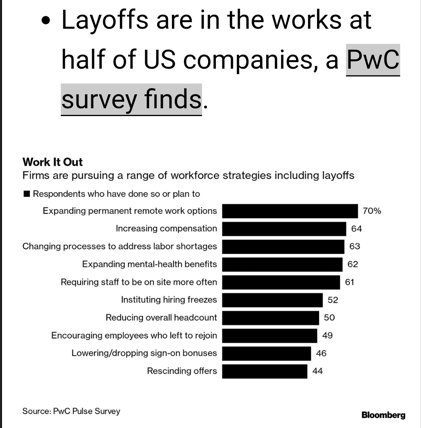
8. Huge short positions building (again) in the market
According to BNP Paribas more than $125 billion in institutional short positions have been building up against the U.S. stock market. These are bets that we are in a bear market still, and the market will eventually decline and head back down. See the chart below.
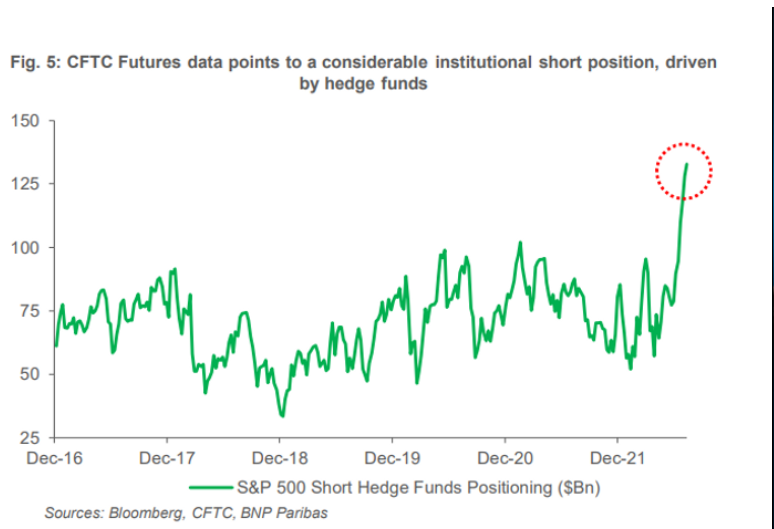
Some of this portfolio positioning comes from the major market indices not yet surpassing their significant moving averages (all still below their 200-day moving averages). This implies to many market technicians that the major averages are still in a "bearish" phase and just participating in a bear market retracement (rally). Time will tell if this is a correct assumption.
9. No capitulation of the June lows
There are numerous strategists who believe we did not experience a bear market low similar to other bear markets and that implies that this recent rally is nothing more than a bear market relief rally. There are two ways of looking at capitulation:
One way, according to Sam Stovall, Chief Investment Strategist at CFRA Research is based a "15-day average of daily percent differences between intra-day highs and lows for the S&P 500. Capitulation occurs when these spikes are well above two standard deviations". Using this definition, the June low did not satisfy a capitulation.
Another definition according to Mark Hulbert of Hulbert Rankings is that "on June 17, the day of what so far had been the bear market's low, the level of stock market timers stood at 33.3%, which was nowhere close to the levels seen at past bear market bottoms. At the bottom of the 2007-2009 bear market, in March 2009, the comparable percentage was 81.0%". Therefore, he believes this is nothing more than a bear market rally. See chart below:
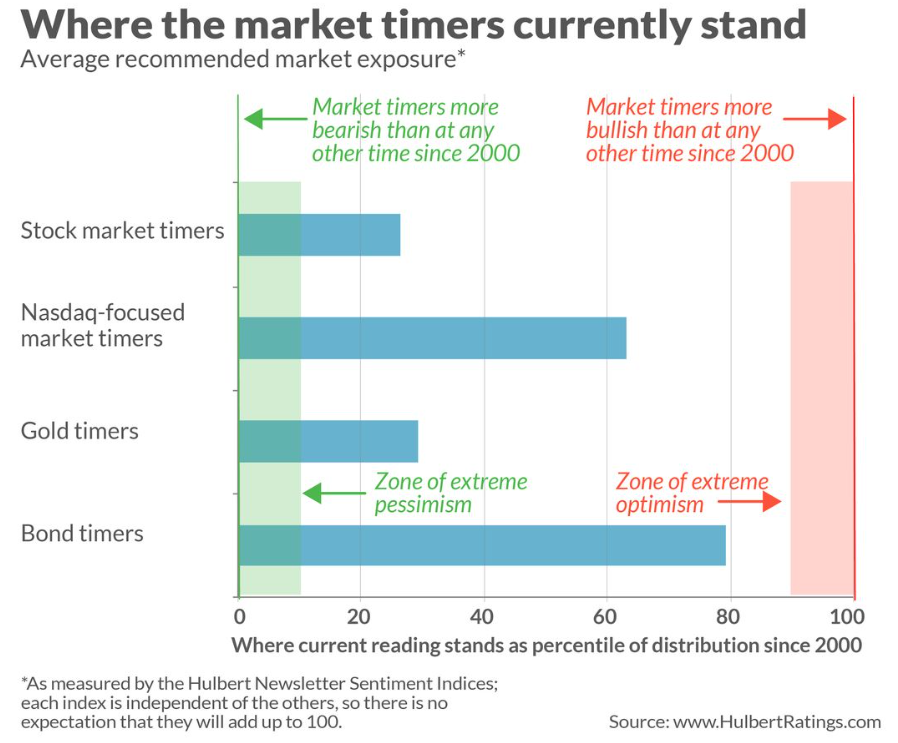
10. Geopolitical surprises
While these are always very prevalent, according to some historical cycle analysts, we are due for a conflict. This is very much a wildcard, but could happen as a surprise given the world's continuing heated rhetoric. China could invade Taiwan, Russia could try and expand its role in Eastern Europe, or the Middle East could incur expanded violence. All of these scenarios remain unforeseen landmines on the horizon.
The overall score of potential economic surprises is more negative than positive, although some are neutral.
We live in one of, if not the greatest, country in the world. Economic conditions go thru boom and bust cycles only to right themselves eventually. We are not sure how all of these factors play out, but we want you to be aware of them.
If you follow us frequently, we have been posting similar warnings since last fall, 2021. We do not think conditions in the U.S. have changed that much. We would like you, our valuable readers, to remain vigilant and not get too exuberant when you see enthusiasm prevail in the short term. These are pivotal times, in our experience, when investors may get complacent, drop their guards, don't pay as close attention to risk management, and potentially get burned on some trades.
Be careful out there!
Here are some of our other observations from Big View this week:
Risk-Off
- All 4 key U.S. Indices failed their long-term 200-day moving averages and look to be mean reverting back towards their respective 50-DMA's as possible support. (-)
- Momentum for the 4 indices is also breaking down, confirming the move in price. (-)
- Despite relatively positive volume patterns over the past 2 weeks, all 4 key U.S. indices closed the week with Friday distribution days. (-)
- Most sectors closed red on the week and were led down by spec sectors like Semiconductors (SMH) -4.2%, while Risk-Off sectors such as Consumer Staples (XLP) +1.9% and Utilities (XLU) +1.3% are positive. (-)
- Market Internals look weak for both SPY and the Nasdaq Composite, with both breaking down hard according to the McClellan Oscillator. (-)
- The number of stocks above their respective 10-day moving averages has broken down hard for both SPY and IWM, an extremely risk-off indication for the short-term trend. (-)
- The Yield Curve remains inverted, a recessionary indication. (-)
- Although Value stocks (VTV) are tackling their own 200-day moving average on price, it is now outperforming Growth stocks (VUG) on a relative basis for the first time sincerely July. (-)
- Every member of Mish's Modern Family has closed below their respective 200-day moving averages, with 4 of the 6 also closing below their current trend lines (excluding IBB and KRE). (-)
- Global Equities continue to lag U.S. Equities according to the Triple Play indicator. (-)
- Oil (USO) is still holding on to its 200-day moving average as support for the time being but has had a bullish golden cross on its weekly moving averages showing that it is continuing to improve on a longer timeframe. (-)
Risk-On
- Risk Gauges remain Risk-On despite the selloff in key indices. (+)
- All 4 U.S. Key U.S. Equity Benchmarks have positive TSI numbers
- Gold (GLD) continued its selloff after failing to reclaim its 50-day moving average, now in a full bearish phase on both price and momentum according to Real Motion. (+)
Neutral
- This week's worst performers were Precious Metals including Gold Minders (GDX) -7.2% and Silver (SLV) -8.4%. (=)
- The New High / New Low ratio for both SPY and Nasdaq Composite still looks relatively strong in regard to its longer-term trend, but shorter-term it looks like this ratio may be beginning to break down. (=)
